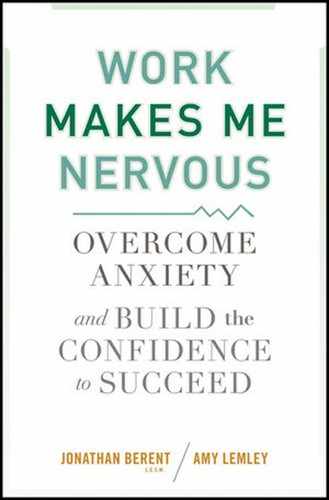Occasionally I half-seriously joke with some clients by asking them, "Would you like to know how to cure performance and social anxiety in one hour?" Want to know the answer? Here it is: Ship yourself off to a war zone. When the tanks are coming after you or you have to sidestep roadside bombs and see people being killed all around you, it's likely that you will put certain feelings like embarrassment, shame, and fear of looking stupid in a more appropriate perspective as you focus on survival. You would feel fear on the front lines. You would feel anxiety. But not because you're afraid the guy next to you will notice if you're nervous.
By now you know that eliminating anxiety is not the answer. Nor is ignoring it and wishing it will go away. We all need our anxiety. We need our stress. Without it, we cannot achieve our personal best. Do you need nerves of steel? No. Must you shift your relationship with adrenaline from one of avoidance to one of welcome? Absolutely.
Not that I am suggesting this is simple. I do not mean to diminish the severity of your anxiety at work. I know how excruciating it can be—I have heard about it thousands of times. Remember David, the Israeli army officer who said he "would rather go door to door in a combat zone than publicly speak"? I recall another client who was working as a construction manager in Iraq; he said basically the same thing. I suppose that Carol, the ovarian cancer survivor who said "I'd rather be back in chemotherapy," is in the same category.
Objective research would demonstrate that I have worked directly clinically with more anxiety sufferers than any other therapist. I challenge anyone to refute this, and I challenge anyone to come forth with more actual documentation of success (as exemplified by both this book and the interviews at www.socialanxiety.com).
Think of your life before this program: Worrying constantly, even obsessively, about what the workday will hold, whether you will go blank when your supervisor asks you a question you aren't prepared for, what colleagues you have let down by missing a deadline. Most people who are nervous at work wait to get help until their survival is on the line: Their nerves are frazzled, they are burning out, their careers are in jeopardy, their relationships at work and at home may be deteriorating, or they have lost their jobs. Unfortunately, the same embarrassment and shame that they feel at work prevents them from acknowledging their problem. The CP-AC twin towers cast a dark shadow, and such people's internal critical script is too loud to ignore. Unless they are objective about it, they cannot take effective action. I wish that weren't the case, but it is reality. All that wasted time, those months and years in which they were depleting their most valuable asset—when they could have been turning that adrenaline into energy to fuel their success. The earlier a person gets help, the less potential there is for the anxiety to work its way into the personality and affect your mind states balance.
At this point, your notes should tell quite a fascinating and uplifting story. Your journey is something to be proud of. You are building a positive history for yourself to which you can return for encouragement (NP) and ideas (NC) and to remind yourself that you set a goal and completed it (AC). If you have followed the instructions and worked this program for 21 days straight, now would be a good time to refer back to your diagnostic exercises. Compare where you were with where you are today. Acknowledge yourself for how far you've come.
If you have followed this program precisely, you can count these significant achievements among your successes:
You are creating your map for change through a series of self-diagnostics.
You are investing in mind states balance, creating profound structural change.
You are learning how to attain and maintain a healthy brain.
You are learning the Five-Step Adrenaline Control Technique, which allows you to make adrenaline your friend and the source of power.
You are beginning to understand the positive impact of paradoxical thinking and behavior.
You have begun to grasp why you should attach vs. detach to thoughts, feelings, and physical cues.
You are perfecting the process of channeling anger into productive energy.
You are doing the deeper work of resolving the emotional conflict that drives anxiety.
You are practicing more than 35 exercises that comprise a systematic Quieting Response that is the most direct way to control anxiety.
You are discovering the true meaning of success.
Now that you have reached the end of this program, you are familiar with the mind states and how each of them can play a positive role in your F.A.T.E. (Feelings+Actions+Thoughts+Emotions). Think back to the mind states, which you have now internalized. Each of us requires all five of these mind states. You can't simply suppress one or allow another to skyrocket. The key is balance. Take a moment to review the Unbalanced Mind States graph that you first saw in Chapter 3 (repeated here in Figure 9.1).
As you look at the graph, recall how it feels when CP and AC dominate the other mind states. Imagine this graph as a dynamic illustration. Picture the Nurturing Parent, Adult, and Natural Child mind states growing. Imagine the CP and AC towers retreating as the other mind states grow.
Now, review the Balanced Mind States graph (repeated here in Figure 9.2).
Focus on this graph for a moment. Really take it in. Move left to right, attaching to each mind state on its own and in relation to the others. Associate it with balance and power. Raising NP, AC, and NC will naturally result in lowering the twin towers, so there is no need to attempt to lower CP and AC. They will retreat as your other mind states advance.
The graph of success shows ups and downs. But the trend line is up, up, up. You have all the tools you need to follow that trend. Will the graph still look jagged? Of course. We all have our better and worse moments, the times when, for whatever reason, we revert to our default. But this program is not about your default. It is about identifying tools, becoming skilled at using them, and taking your toolbox with you wherever you go. I see Amy as a success in this regard. She still responds to stressors with anxiety, detachment, and avoidance. Those things are her default. But she now routinely opens her toolbox and selects the right instrument for converting her adrenaline into energy, for attaching to the facts of the matter, and for confronting rather than avoiding. If she falls off the horse, she gets right back on. Here is Amy's description of what she does:
Anxiety shows up. The first thing I do is the Awareness Exercise. What is the temperature of my hands? What are my thoughts and feelings? I attach to those feelings and let myself feel them rather than pushing them down. I then let my mind states "speak" to the issue that is upsetting me, and I extract an empowering message from each. Once I achieve balance, I "tune in" again with the Awareness Exercise. The entire process I've described to you takes me maybe five minutes max.
Managing my integrity as a health practice requires that I use mind states balance to first, see where I fell off the integrity wagon, and next, restore my integrity by being in communication, and recommitting to meet the deadline, complete the task, or learn the skill I was lacking.
The strategies in this book exist in service to mind states balance. If you have worked this program to the letter—practicing and perfecting each technique right down to the number of seconds I specify—you should be seeing a difference in your anxiety level at work. Your mind states should be balancing; if they start to shift, you now know how to recognize that shift and what to do to adjust the dynamic. Keep using these strategies—your skill will continue to increase over the years. I plan to count you among the thousands of success stories this program has produced. Please take my confidence in you as a compliment, and pause to access your Nurturing Parent, Adult, and Natural Child mind states as you reflect on the techniques you have learned, among them:
Hand Temperature Awareness Exercise, page 14
Five-Step Adrenaline Control Technique, page 26
Diaphragmatic Breathing, page 27
Tuning In: Feelings List, page 29
Heaviness Exercise, page 107
Problem-Solving Technique, page 108
Imagery Exercise, page 123
The Five-Minute Integrated Biofeedback Exercise, page 133
The Stress Reinterpretation Exercise, page 156
The Quieting Response Exercise, page 159
The Embarrassment Challenge Exercise, page 168
Daily Attachment Exercise, page 178
Nurturing Attachment Exercise, page 179
Embarrassment-Logic Exercise, page 184
Most of my clients begin therapy with me by asserting that if they ignore their anxiety problem, it will disappear. Taylor, age 35, was his firm's top investment professional. He made a very good living. But he suffered anxiety in anticipation of meeting with potential clients. His anxiety caused him to stammer, which lasted into a meeting's first 10 minutes before he could get it under control. This went on for years, yet Taylor checked 5 = "strongly agree" with the statement "If I ignore my anxiety, it will go away," on my treatment history form. Sadly this belief, which derives from the excessive Critical Parent mind state, makes the problem worse.
Of course, the learning curve for resolution of social and performance anxiety is different from person to person. When new clients ask "How long will this take?" my answer is, "How fast can you run?" Meaning how fast can you learn? The primary variables include severity and length of the problem, the level of motivation, ability to integrate new concepts, expressive ability, and readiness to face fear. And practice—as often as possible.
How thoroughly did you work this program? Have you invested in mind state balancing? How has this work affected your F.A.T.E.?
Feelings:
____________________________________________________
____________________________________________________
Actions:
____________________________________________________
____________________________________________________
Thoughts:
____________________________________________________
____________________________________________________
Emotions:
____________________________________________________
____________________________________________________
What is the primary positive difference you are seeing in yourself?
____________________________________________________
____________________________________________________
____________________________________________________
____________________________________________________
What will you do to maintain and develop this difference?
____________________________________________________
____________________________________________________
____________________________________________________
____________________________________________________
Resolving workplace anxiety requires resolving excessive shame, embarrassment, and humiliation. To do so, you must identify and attach to those emotions rather than ignoring or suppressing them. You have been using the Feelings List on page 29 in Chapter 1 to identify your emotions. Naming them brings them to the forefront, where you can attach to them and confront them head on. When emotions are out of control, anxiety wins. As for a "resolution"—I do not use this word easily. "Resolution" requires you to maintain mind states balance. People who operate with a High Performance Mind are constantly balancing their mind states for optimal productivity and well-being. They are in control of their emotions and their actions. They are in control of their F.A.T.E. They have made mind states balance a way of life.
Embrace your emotions. They are real and important and crucial to your self-expression. Unless you have the skills to move forward despite the emotions you are feeling, your nervousness at work will continue. What is courage? Action in the face of fear. Here's a metaphor: Amy once saw a little Chihuahua out in his front yard barking furiously at a huge Rottweiler across the street. He was acting as fierce as possible, snarling and barking through the fence boards. Amy peered over and saw that he was peeing down his back legs the whole time—no doubt from the heightened anxiety and fear of confronting the big dog. Action in the face of fear.
The need for increased productivity and performance within an increasingly technological and competitive world is going to continually increase. Do you define success as happiness? You should. A recent study found that "Therapy is 32 times more cost-effective at increasing happiness than money." Believe me, I have worked with countless wealthy individuals who have been tormented by anxiety.
"Governments pursue economic growth in the belief that it will raise the well being of its citizens," states the report entitled "Money or Mental Health: The Cost of Alleviating Psychological Distress with Monetary Compensation versus Psychological Therapy." However, the research suggests that more money only leads to tiny increases in happiness and is an inefficient way to increase the happiness of a population. The research suggests that if policy makers were concerned about improving well-being they would be better off increasing the access and availability of mental health care as opposed to increasing economic growth.
Thousands of patients have told me how hard it was for them to find productive, effective help for workplace anxiety. Psychiatrists see avoidant personalities as indelible, and they scarcely know how to address selective mutism. This is the state of traditional therapy today and it personifies anxiety treatment in general. You are lucky and skilled because you have worked through this book. You have learned what is necessary to resolve your nervousness at work so that you can develop the confidence to succeed. Amy describes her own newfound freedom as follows:
For me, the difference between my life before working this program and after is not perfection—that is not possible. Ultimately, the difference is attachment: to my fears, my disappointments, my limitations, my strengths, my weaknesses, my anxiety symptoms, my adrenaline, and ultimately, myself. Being nervous at work is not "just the way I am." It is not out of my control. But I must attach to it.
A High Performance Mind is a mind in balance. A mind in balance knows that we all have stress and always will—that we need it.
I use the hand-warming technique daily. I keep Jonathan's Biocard on my desk, and I check it often. I also do the Breathing Exercise whenever I happen to check the clock. It takes only seconds, and it has changed my physical comfort more than pain relievers had. I use the imagery exercise before any meeting I dread. I used the Problem-Solving Technique just a few days ago when I lost track of exactly where we were in the book revision process.
Triumph over anxiety is a major accomplishment—for me, and for you. The cage door is open. You are ready to fly. You can now be all that you are, all you know yourself to be. Will there be setbacks? Yes. Will you feel that familiar flow of adrenaline and sometimes react with fear? Probably. But now, you know what to do about it. Use these strategies every day. Notice or generate situations in which to practice. Make a note of your results. When you find yourself reverting to your "old ways," determine what stopped you from using your new toolkit. Walk yourself through a mind states assessment. I actually count it out on five fingers, thumb to pinkie—Nurturing Parent, Critical Parent, Adult, Adapted Child, and Natural Child—to be sure I take each "voice" into consideration.
What are you hearing from your internal critical script? What should you replace it with? Go through each mind state again and correct—dialing Nurturing Parent, Adult, and Natural Child up; Critical Parent and Adapted Child will then start to recede. All mind states are essential. Do not attempt to shut one down completely or turn another one all the way up. Return once again to the Unbalanced Mind States graph, Figure 9.1. Imprint the image in your memory. If possible, animate it in your mind's eye: Picture it shifting from imbalanced to balanced: NP, A, and NC grow as CP and AC shrink somewhat. The Balanced Mind States graph, Figure 9.2, is the result.
With balanced mind states, you can operate with a High Performance Mind. And with a High Performance Mind, anything is possible. You can pursue your destiny, which by rights includes contentment, fulfillment, well-being, and full self-expression. Accept that you have the tools to abandon your fear of nervousness and get on to other things. Conquering anxiety is not the same as eliminating it. We all need our anxiety. As famed life coach Tony Robbins says, "Frustration is good. It gets you to the next level." If you stay stuck, if you detach from the feeling of paralysis, you will never progress. This is why you have been training yourself to convert your adrenaline to energy. It is okay to have anxiety. It is not okay to let the anxiety control you. You don't need to avoid. You are free now. Free to be yourself.
Our deepest fear is not that we are inadequate. Our deepest fear is that we are powerful beyond measure. It is our light, not our darkness, that most frightens us. We ask ourselves, Who am I to be brilliant, gorgeous, talented, fabulous? Actually, who are you not to be? Your playing small does not serve the world. There is nothing enlightened about shrinking so that other people won't feel insecure around you. We are all meant to shine, as children do. And as we let our own light shine, we unconsciously give other people permission to do the same. As we are liberated from our own fear, our presence automatically liberates others. | ||
| --Marianne Williamson, A Return to Love | ||
You want a High Performance Mind? Invest in the belief that anxiety is excitement in need of an attitude adjustment.
What is the temperature of your hands?


